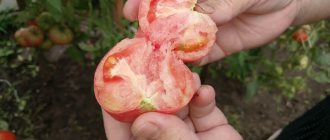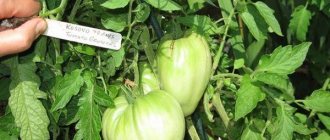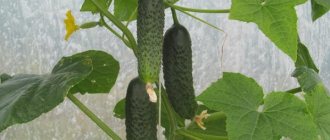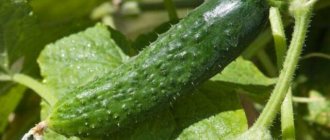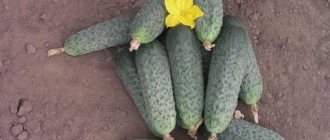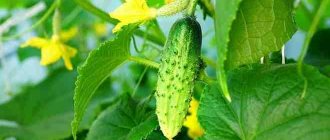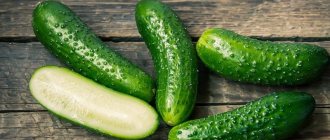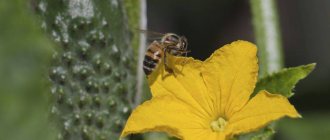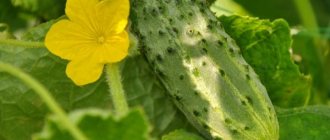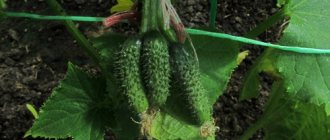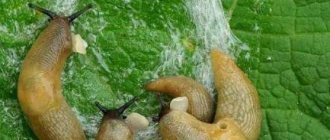Vyaznikovsky 37 is a blonde universal cucumber, resistant to northern climates. The fruits are good pickled and fresh.
| Landing location | Ripening time | Mode of application | Fruit length | Group | Fruit smoothness | Pollination method |
| Universal | Early ripening (35-45 days) | Universal | Short (gherkins) - less than 10 cm | Variety | Highly lumpy | Bee pollinated |
Description and characteristics of the variety
The variety is bee-pollinated; the bushes grow short-climbing, with 3-4 lateral stems.
Peculiarities:
- harvesting early - after 40-55 days;
- adaptation to temperature changes.
Description of greens:
- length 10-12 cm;
- weight 90-100 g;
- diameter 2-3 cm;
- color light green;
- elongated-ovoid shape;
- the flesh is crispy and tender;
- tubercles small, frequent.
The fruits are used fresh and canned.
General description of the plant
The description of the variety Vyaznikovsky 37 classifies it as an early ripening variety. The harvest can begin to be harvested already 35-40 days after emergence. During the period of active fruiting, up to 3 kg of fruit can be collected from 1 m² in 1 day. The bushes are resistant to cold snaps in mid-summer and temperature changes. Cucumbers can be grown in the southern regions (Krasnodar Territory) and in the difficult conditions of the Urals and Siberia.
Vyaznikovsky cucumbers are suitable for open and closed ground. When planting in a greenhouse, you need to take into account that the variety is bee-pollinated, so you should leave the door open so that insects can get inside. The characteristics given by gardeners note that Vyaznikovskie bear fruit best when cultivated in open ground or film greenhouses.
Vyaznikovskie 37 cucumbers are resistant to fungal diseases (powdery mildew, etc.). When temperatures change in mid-summer, they do not taste bitter. They are resistant to slight drying out of the soil, but in severe drought they require daily watering.
The vines are short, up to 2 m. When grown on a trellis, formation is required: 3-4 flowers with ovaries are left on each side shoot, and then pinched. Without a garter, the lashes lead into 3-4 sleeves, receiving several shoots from 1 root.
The leaves are medium-sized, with a non-wrinkled blade. To prevent disease, it is recommended to remove old leaves that are beginning to turn yellow.
Landing
Seeds for seedlings are sown to a depth of 1-2 cm. The bushes are planted in a permanent place at the age of 25-30 days
Watering
Plants love moist soil and are watered in the evening or early morning. Frequency: 1 time every 2 days, every day in hot weather.
Feeding
Feed according to general rules. Organic and mineral compounds are used. Fertilize 4-5 times per season. The first time feeding is carried out with 2 leaves. Then water the garden with nutrients once every 2 weeks. The presence of a nitrogen-phosphorus-potassium complex is required.
Formation of bushes
The procedure activates the growth of lateral shoots and increases the number of female ovaries. The central shoot is pinched above the 5th leaf.
General information about the Vyaznikovsky cucumber variety
Vyaznikovsky cucumber 37 was bred back in the 19th century; Russian breeders grew it both in the Moscow region and in Vladimir. The variety and its varieties were included in the collection of the All-Russian Institute of Genetic Resources 94 years ago.
Cucumber Vyaznikovsky
Characteristics and detailed description of the external differences of the variety
- the variety is an early ripening species, the fruits ripen after approximately 45 days;
- pollinated by bees;
- high-yielding, from 1 sq.m. you can get up to three and a half kilograms of vegetables;
- plant height is average;
- leaf color is green, no wrinkles;
- leaves are medium in size;
- fruits are set in a bunch manner;
- the plant usually produces up to 4 additional shoots;
- the fences are quite short, but strong;
- is immune to many diseases;
- tolerates short-term temperature drops well;
- perfect for long-distance transportation.
Vyaznikovsky cucumbers can be grown both in open ground and in greenhouses. The variety is quite resistant to various unfavorable factors; in addition to Russia, it is also very popular in Ukraine and Moldova. It is especially actively cultivated in the middle Russian latitudes, the reason for this is the variety’s resistance to a changeable climate.
In the greenhouse
Technical information and descriptions
- the fruits of the plant have an elongated shape, slightly reminiscent of an egg;
- the fruits have small tubercles;
- fruit color - light green;
- the fruits reach 9 to 11 cm in length;
- the weight of one fruit, as a rule, does not exceed 135 g;
- cucumbers have a delicate, rich taste without bitterness;
- have a rich odor;
- They have a fairly dense core; empty fruits are almost never found.
Thanks to its refined taste and fairly small size, the Vyaznikovsky cucumber is perfect for pickling. The fruits are also often used in salads. The absence of bitterness and voids make them an indispensable ingredient.
Canned cucumbers
Advantages and disadvantages
The main advantages of the Vyaznikovsky 37 variety:
- Fast ripening of fruits;
- Plants are not afraid of adverse weather conditions;
- Excellent taste of cucumbers;
- Friendly return of the harvest;
- Tolerates short-term frosts well;
- Persistent immunity to a large number of different diseases;
- Universal use of the crop;
- Long shelf life;
- Cucumbers withstand transportation well over long distances.
Care
Caring for the Vyaznikovsky 37 variety does not require much effort. It consists of the following actions:
- Maintaining the correct watering regime for cucumbers;
- Regular loosening of the soil in the area with vegetables;
- Timely application of nutritious fertilizers;
- Bush formation.
Plants should be watered only with warm water. Before flowers appear on the bushes, moderate watering is carried out. During the fruiting period, the bushes need additional water.
The first fertilizing is carried out with nitrogen-containing fertilizers. During the period of flowering and the formation of ovaries, fertilizing with a high content of potassium and phosphorus is applied to the soil.
Open ground is characterized by two methods of plant formation:
- Tie the stem to the trellis;
- Plant creeping along the ground.
How to grow a variety yourself
Cultivation of Vyaznikovsky cucumbers is simple. They are immediately sown in the ground or grown as seedlings.
Vegetables tolerate planting seeds in open ground well. To do this, a number of conditions are met:
- soil temperature - not lower than 15°C;
- the planting area is reliably protected from the wind;
- There should be as much sunlight as possible.
Planting is carried out after frosts have passed and during stable warm weather. In most regions of Russia this is the end of May.
The bed has been prepared since the fall. To do this, they dig up the ground and add a composition of the following per 1 m2:
- leaf humus - 5 kg;
- wood ash - 1 l;
- superphosphate - 20 g;
- potassium salt - 10 g.
The mixture is disinfected with a weak solution of potassium permanganate.
The crop is sown for seedlings approximately on the 20th of April. The growing period should not exceed 4.5 weeks, otherwise the plant yield will decrease sharply.
A mixture of soil, humus, peat and sand in equal proportions is best suited for cucumber seedlings. The substrate is watered with hot water for disinfection. After the liquid has drained, potassium sulfate, urea, Nitrophoska and wood ash are added.
Preference is given to growing vegetables in peat cups, since the roots of the variety are fragile and do not tolerate picking well. Some cultivate seedlings in sawdust: with this method, the root system is not damaged, but develops easily and freely. In any container, make a tray and drainage at the bottom in the form of expanded clay or sawdust.
Before planting, seeds are placed in a saline solution (30 g of salt per 1 liter) for culling. Only those specimens that sink to the bottom are used. Planting material is disinfected in a weak solution of potassium permanganate. The soil is well moistened.
Plant seeds 2 per pot or hole. After germination, the weak sprout is removed.
Watering begins on the 5th day after germination. Moisten the soil regularly, but moderately. The pots are placed in a well-lit place, at a certain distance from each other, so that the leaves of the grown seedlings do not touch.
A week before planting in open ground, the plants begin to harden off, periodically taking them out onto the balcony or loggia.
Growing and care
There are 2 ways to grow crops:
- lashes are thrown along the ground;
- with the help of supports.
The first option is simpler and in the case of the Vyaznikovsky variety is quite acceptable, since the vines of these cucumbers are the same length.
However, on supports, when grown vertically, the plants are more evenly illuminated, blown with fresh air and pollinated by bees. Bushes are less attacked by pests. Productivity with such cultivation is usually higher.
Warm water is poured into the holes between the rows - the soil should be moist at all times. Vyaznikovsky cucumbers are irrigated before the heat starts in the morning or evening. Do this regularly, at equal intervals. When watering, water should not get on the leaves to avoid burns to the plant tissue.
Before flowering, the crop is moistened moderately, and during fruiting - abundantly. The quality and quantity of the harvest depends on this.
If organic matter was not added before sowing seeds or seedlings, the soil is periodically fertilized with Ammophoska or mullein solution. Regular chicken droppings will also work, but in small quantities.
The roots of the Vyaznikovsky cucumber are located close to the surface. Therefore, plants are hilled several times during the summer to prevent the development of fungal diseases.
To form side shoots on which female flowers are formed, the main stem above the 5th leaf is pinched. However, if the fruits are formed early, which is typical for the southern regions, the procedure is not performed.
When growing Vyaznikovsky cucumbers, farmers are faced with the formation of an insufficient number of ovaries. In this case, bees are attracted for better pollination of the bushes by planting honey-bearing flowers next to the beds or placing drinking bowls with a sweet nutrient solution.
Diseases and pests
To prevent diseases, bushes are treated with ash, for treatment - with fungicides, “HOM”.
In conditions of high humidity, plants can be attacked by spider mites. A solution of potassium permanganate and special biological products are used against it. Affected leaves are torn off and destroyed.
The Vyaznikovskie cucumber variety is incomparable fresh and good for winter preparations
Cucumbers have been grown in Russia for a long time and successfully. It’s hard to imagine a summer dinner table and summer cottage without these vegetables. There are many varieties of the crop with their own characteristics, taste and appearance of the fruit. Let's take a closer look at the Vyaznikovsky cucumber variety.
Description of the variety
Vyaznikovsky cucumbers were known in our country back in the 19th century. They were especially actively grown in the Vladimir region. The variety was first cultivated in the city of Vyazniki.
Distinctive features
The All-Russian Institute of Genetic Resources included the variety in its register back in 1924. Born in Vyazniki, it quickly spread throughout Russia and other countries of the post-Soviet space, especially Ukraine and Moldova.
The reason for this is not only the good taste of the fruit and its presentation, but also the resistance of the variety to weather changes. It tolerates sudden cold snaps and unexpected heat well, which is especially valuable in a sharply continental climate.
Agricultural technology
Vyaznikovsky 37 can be grown in seedlings or sown directly into the ground. Direct sowing is carried out as soon as the soil warms up to 15 ° C (at night the temperature should not fall below 8 ° C). Such conditions are possible in late May - early June. The seedling method is more popular as it allows for earlier production. Seeds are sown for seedlings in early May. 20-day-old seedlings are planted in a permanent place; the plants should have at least 3 - 4 true leaves. The recommended planting density is 3 - 4 pieces per 1 square meter. The variety requires highly drained, nutritious soil; loams with neutral acidity are well suited. The crop can be grown spread out or tied to a support. In the growing process, traditional agricultural technology is used. Given the weak drought resistance of cucumber, special control is given to watering.
Vyaznikovsky 37 is one of the most common and famous varieties in Russia. Good yield, reliability and excellent taste of fruits are highly valued by gardeners. Care is quite easy; even novice vegetable growers can cope with cultivation. The harvest is suitable for consumption in its natural form, for canning and pickling. A big plus is the ability to independently collect seed material. Disadvantages - insufficient drought resistance of the cucumber and dependence on high-quality pollination.

